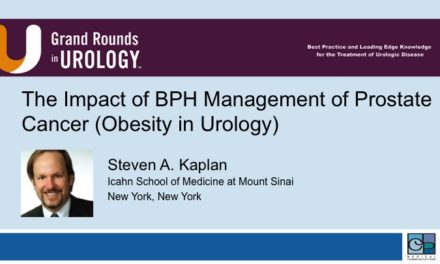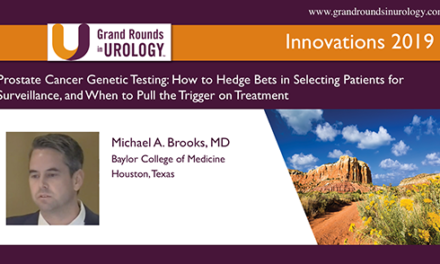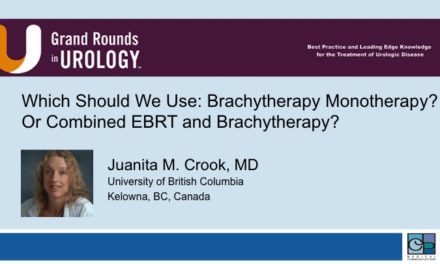Dr. Nelson N. Stone spoke at the 25th International Prostate Cancer Update on Thursday, January 22, 2015 on “Prostate Biopsies: Where Have We Been and Future Directions.”
Keywords: prostate biopsies, lesion, mapping
How to cite: Stone, Nelson N. “Prostate Biopsies: Where Have We Been and Future Directions” Grand Rounds in Urology. May 12, 2015. Accessed Dec 2024. https://dev.grandroundsinurology.com/prostate-cancer-nelson-n-stone-prostate-biopsies/.
Transcript
Prostate Biopsies: Where Have We Been and Future Directions
History of prostate biopsy. Really the first time prostate cancer was described under the microscope goes back to 1857. The first real needle biopsy of the prostate was done in 1951. That’s the same type of technology I used as a resident that was developed back then. As I said, Fred Lee was the first to describe the TRUS-guided biopsy in 1987. Believe it or not, Guy Vallancien was the first to describe the transperineal biopsy in the exact same year.
What’s the story with biopsies today? Well, the 12-core standard transrectal biopsies are 1.2 million biopsies done today in the U.S. to look for prostate cancer. We have now new technology that maybe will cut this down or make it more accurate. You’re going to hear about the multiparameter MRI. I’m going to talk about transperineal biopsies because that’s my area of interest.
The standard one which I’ve been doing for over 10 years and Dr. Crawford I know has been doing for over 10 years is template-guided. Where I’m going to be pointing us towards is more of a 3-D mapping-guided biopsy.
What’s the algorithm look like in terms of newly-diagnosed prostate cancer? With a TRUS-guided biopsy, about 20,000 patients getting diagnosis of Gleason 8-10 and they’re going to get radical prostatectomy or radiation therapy. The overwhelming majority of patients really have these low to intermediate risk features. The question is: should they have surgery? Should they have radiation? Should they go into a surveillance group? We don’t really know the answer to this problem.
When we’re thinking about surveillance, we have lots of tools today. We have the genetic and epigenetic assays, we have rebiopsy, and we have multiparameter MRI. Again, it’s a mixed bag about where we should be headed. What’s the best methodology to really decide who’s a good candidate for surveillance?
What about focal therapy? Is there a technique of rebiopsy? I think the genetic or epigenetic assays maybe are not going to be good for this and maybe we could use multiparameter MRI, but focal therapy I think is going to become a big player once we have an accurate way to know where those lesions are.
Here’s part of the problem. You do a prostate biopsy. You find a small lesion up here. You don’t see the lesion down here. Actually, recent data is now suggesting that even though this may be your important lesion because it’s a higher Gleason score, this lesion down here has a 25% chance of also being high grade and has a genetic difference than this lesion. That’s a problem if you sample one of these and you send it for a genetic assay. It may not be telling you the true story as to what the potential is because you don’t know anything about that lesion.
This is the French study where they did 10,000 prostatectomies and a little less than a thousand with very low risk. Only 26% had insignificant tumors. Not 50% of 60%, just 26%. A minority of the patients who have apparent low-risk disease by transrectal biopsy truly have low-risk disease or very low-risk disease.
What about your practice? Most people practice this way. They do a biopsy. They find low-risk prostate cancer. They want to put a patient under active surveillance. A lot of people are doing now rebiopsies a year or two years later. This is a paper from Stacy Loeb. Look at what’s happening with the infection rate. It’s gone up now to probably closer to 3%. What you calculate is every extra biopsy you do increases the risk by 1.7 times that patients are going to need to be hospitalized or are going to get a serious infection. This is getting worse and worse as we do more and more rebiopsies.
Why do we have this dilemma? When Dr. Crawford and I first started to get involved with prostate cancer screening, the cancers were very large. They were actually very easy to hit with the ultrasound-guided biopsy. That’s no longer the case. Today lesions are very small or they’re located in regions that are not discoverable by DRE or TRUS-guided biopsy.
This has resulted in the 12-core biopsy being a semi-blind procedure. Rebiopsy using the same technologies does not yield better results. Just doing the same thing over and over again is not going to help us. Now we’re starting to see this. We’re going to get backlash. This is an article that came out a couple of years ago in the Houston Chronicle quoting a patient. I don’t know if screening saves lives, but it sure helps sell diapers. No wonder patients don’t want to have screenings. We’re applying PSA; we’re doing semi-blind biopsies. We’re telling them they can have active surveillance. Half of them can have active surveillance because they truly have low-risk disease. But half of them have more cancer in there that needs to be treated. We treat them. Half of them didn’t need it. If we don’t treat them, maybe half of them should be treated. I think our patients are getting a little disgusted with us.
Let’s talk about transperineal template-guided prostate biopsy. This is how it’s done in the OR. The urologist is putting the needle in through a template. He’s watching on the ultrasound screen. They can see the needle coming in here into the prostate on sagittal imaging.
The transperineal approach was really well first described by Gary Onik and Winston Barzell. They reported on 110 patients with unilateral disease. They took a median of 46 cores. These were patients who were active surveillance candidates. They found bilateral disease in 55% and upgrading in 23%. It’s what you would expect because you find that in the prostatectomy patients.
However, we try to do this transperineal mapping biopsy. Keep in mind the equipment we’re using was developed 30 years ago for transrectal biopsy. It wasn’t developed for transperineal biopsy. The biopsy needle was designed for a different application. It’s too short and has a limited core. There’s no software that provides real-time tracking, representation, and recall. If you’re trying to do a systematic “saturation biopsy,” you people who have familiarity with brachytherapy know every time you stick a needle in the prostate it jumps. If you can’t record where you were and know where the next needle should be, you’re not really doing a fair representation of what’s in the prostate.
The last thing is very important. The procurement of tissue when you take a biopsy hasn’t changed for 100 years. You take a biopsy; you put it on a piece of gauze; you put it in formalin. It goes to the pathologist. It falls apart. We don’t really care. We never cared in the past because we just wanted to know if there was cancer there. But the world is changing. We need to know where that cancer is exactly on that core in case we’re thinking about focal therapy. That needs to be changed.
How do you do that? We need a needle that does this. You put it at the apex. You fire the needle. It goes the entire distance from apex to base in one core. You have to be able to use a gun where you can dial the distance, so if you’re here in the prostate or down here in the prostate it’s not going to puncture the bladder. Needle that takes a core, one distance.
We did some work in trying to analyze exactly what size needle ewe needed to find the lesion of a certain size. What we found–this comes from a paper by Kepner [phonetic]–that if you use a 15-gauge needle and you take biopsies at 5 mm intervals, which is your typical template, and you look to see how you can find a lesion of a certain size, if you’re looking at a 2.5 mm radius, the probability of finding that lesion using the system idealized is 97%. This system will find every significant and probably sub-significant clinical lesion. We’ll talk a little bit more about that.
How do you do that? We developed a mapping plan, a mapping software. This is based on a phantom. It takes the prostate similar to brachytherapy, makes it into a 3D model. The software then generates the plan, so you see the biopsy sites indicated here. You can change those based on the probability of detecting a lesion of a certain size. It has a sagittal mode, so when you put the needle in you actually see the core here and you can move these around. Then you get a dialogue box which displays the core and tells you the specifics of that core.
Here is the pathologic set I talked about. You can just put the core here. You snap it closed and it holds the core intact. That’s how it gets to the pathologist.
Let’s talk about a case. The software is actually in use now in two centers, one in the U.S. and one in Europe. This is a case that we had, 63-year-old man with a PSA that went up slightly. Normal prostate size. He had a TRUS biopsy, one core positive, 30% Gleason 6, 11 cores negative, and a healthy guy with low IPSS and SHIM. Typical guy you might put on surveillance. Brought him in the OR.
This is the mapping software showing the biopsy plan, prostate, rectum, urethra. We’re going to go hit this needle here, number one. We did finish the plan. He had his biopsies. The pathology showed five lesions. You can see the lesions, one, two, three, four, five in the prostate. The largest of which was down here was a Gleason 7. What you’re going to do with this patient is a Holter from discussion, but at least you know you can see you have a very accurate map of this patient’s prostate. This information can be uploaded into a treatment planning system so if you wanted to do cryo, wanted to do brachytherapy and just put C’s around the lesion, you could even theoretically put gold fiducials in each of these lesions. Just shoot at the gold fiducials and you do focal therapy with IMRT.
3D mapping gives the most accurate determination of pathology within the prostate gland. We’re getting into the area of interprostatic staging. Clinicians will be better able to stratify patients for active surveillance or treatment of focal therapy. Over-detection is not an issue because active surveillance now becomes accurate surveillance. We want to move away from active to accurate. Once you have accurate surveillance, you don’t need a follow-up biopsy. You probably even never need a follow-up PSA. Of course we need to do clinical trials to prove this concept.
References
Beauval JB, Ploussard G, Soulié M, et al. Pathologic findings in radical prostatectomy specimens from patients eligible for active surveillance with highly selective criteria: a multicenter study. Urology. 2012 Sep;80(3):656-60. 7.
http://www.ncbi.nlm.nih.gov/pubmed/22770616
Lee F. Transrectal ultrasound in the diagnosis, staging, guided needle biopsy, and screening for prostate cancer. Prog Clin Biol Res. 1987;237:73-109.
http://www.ncbi.nlm.nih.gov/pubmed/3317434
Loeb S, Carter HB, Berndt SI, et al. Complications after prostate biopsy: data from SEER-Medicare. J Urol. 2011 Nov;186(5):1830-4.
http://www.ncbi.nlm.nih.gov/pubmed/21944136
Mazzucchelli R, Scarpelli M, Cheng L, et al. Pathology of prostate cancer and focal therapy (‘male lumpectomy’). Anticancer Res. 2009 Dec;29(12):5155-61.
http://www.ncbi.nlm.nih.gov/pubmed/20044631
Melick WF. Needle biopsy of the prostate: a new needle biopsy instrument. J Urol. 1951 Sep;66(3):408-11.
http://www.ncbi.nlm.nih.gov/pubmed/14861969
Onik G, Barzell W. Transperineal 3D mapping biopsy of the prostate: an essential tool in selecting patients for focal prostate cancer therapy. Urol Oncol. 2008 Sep-Oct;26(5):506-10.
http://www.ncbi.nlm.nih.gov/pubmed/18774464
Thompson H. Some Observations on the Anatomy and Pathology of the Adult Prostate, founded upon Fifty Preparations of the Organ, dissected by the Author, and accompanying the Paper; with Two Plates. Med Chir Trans. 1857;40:77-106.3.
http://www.ncbi.nlm.nih.gov/pubmed/20896090
Vallancien G, Leo JP, Brisset JM. Transperineal prostatic biopsy guided by transrectal ultrasonography. Prog Clin Biol Res. 1987;243B:25-7.
http://www.ncbi.nlm.nih.gov/pubmed/3309985
ABOUT THE AUTHOR
Nelson N. Stone, MD, is Professor of Urology, Radiation Oncology, and Oncological Sciences at the Icahn School of Medicine at Mount Sinai and at the Derald H. Ruttenberg Cancer Center at Mount Sinai. He also serves as CEO of 3D Biopsy, LLC.
Dr. Stone earned his medical degree from the University of Maryland in 1979. He completed a Residency in General Surgery in 1981 at the University of Maryland, followed by a Residency in Urology at the University of Maryland. He then completed a Fellowship in Urologic Oncology at Memorial Sloan-Kettering Cancer Center and a Research Fellowship in Biochemical Endocrinology at Rockefeller University in 1986. He was Chief of Urology at Elmhurst Hospital from 1989-1996.
Dr. Stone has founded several medical companies and serves on the editorial board of many scientific journals. He is a member of many professional societies, including the Prostate Conditions Education Council, the Society for Minimally Invasive Therapy, the New York State Urological Society, the American Association of Clinical Urologists, and the American Urologic Association. Dr. Stone has participated in approximately 25 research studies on prostate cancer and has authored more than 400 articles, abstracts, and book chapters, primarily on prostate cancer. He invented the real-time technique for prostate seed implantation in 1990 and has trained more than 5,000 physicians worldwide on prostate brachytherapy through his company ProSeed. His company, 3DBiopsy, Inc., is developing variable length biopsy devices, mapping software, and an integrated pathology system.





